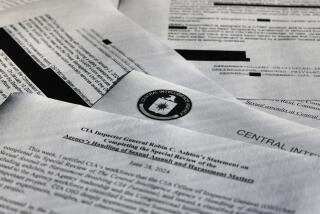TV Review : ‘Frontline’ Catches the Top U.S. Spy Catcher
- Share via
We may never know the full extent of the mad activity that consumed the espionage netherworlds of the superpowers during the Cold War, but we are beginning to get at least a rough outline.
And the outline is scary enough.
As master spy novelist John Le Carre has so often revealed, the spy business--once you’re in it up to your neck--is nothing more than a network of individuals, some with more power than others. British journalist Tom Mangold, in a gripping “Frontline” report, “The Spy Hunter” (tonight on Channels 28 and 15, 9 p.m.; Channel 50, 10 p.m.), has painstakingly tracked the course--and the damaged lives and policies--left by one man: James Angleton, perhaps the CIA’s most legendary, shadowy figure and the top U.S. spy catcher during the coldest winds of the Cold War.
With the testimony of several retired CIA operatives close to Angleton, Mangold unveils a story (also coming this summer to a bookstore near you) that tells of a mind so consumed with visions of global Soviet takeover that only the most paranoid scenarios were given credence. Angleton, once a Yale scholar of poetry, became in the 1950s the chief of CIA counterintelligence, which lured Soviet KGB agents into the Western fold and sought to upset KGB activities with “moles” of its own.
Mangold suggests that a betrayed friendship with notorious British mole Kim Philby concretized Angleton’s distrust of anyone. Yet this is contradicted by the all-powerful Angleton’s subsequent alliance with Anatoliy Golitsyn, who posed as a defecting KGB major domo, but was in fact a minor analyst. Though ex-CIA psychologist John Gittinger diagnosed Golitsyn as paranoid, his imagined so-called “Monster Plot,” in which the Soviet Union would defeat the West through deception and fakery, seduced Angleton. Together, they would find spies and fake defectors where none seemed to be.
In a string of stunning accounts, “The Spy Hunter” unravels the tragic legacy of the Angleton-Golitsyn plots, including the return of a genuine KGB defector, Yuri Loginov, to his former Soviet masters. Taking a tip from the “Inside Edition” school of reporting, the film inserts coy black-and-white dramatization clips, but it doesn’t undercut the disturbing subtext that madness has run rampant at the CIA.
More to Read
The complete guide to home viewing
Get Screen Gab for everything about the TV shows and streaming movies everyone’s talking about.
You may occasionally receive promotional content from the Los Angeles Times.






